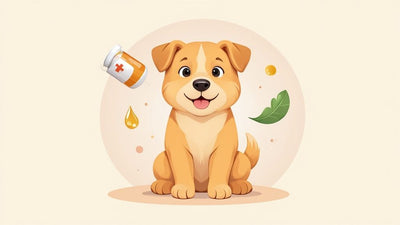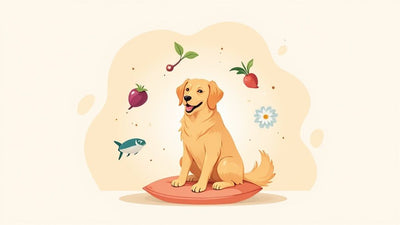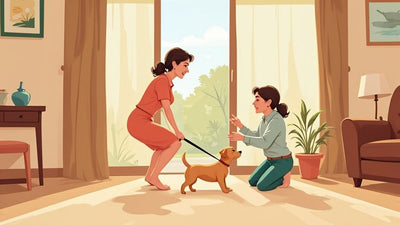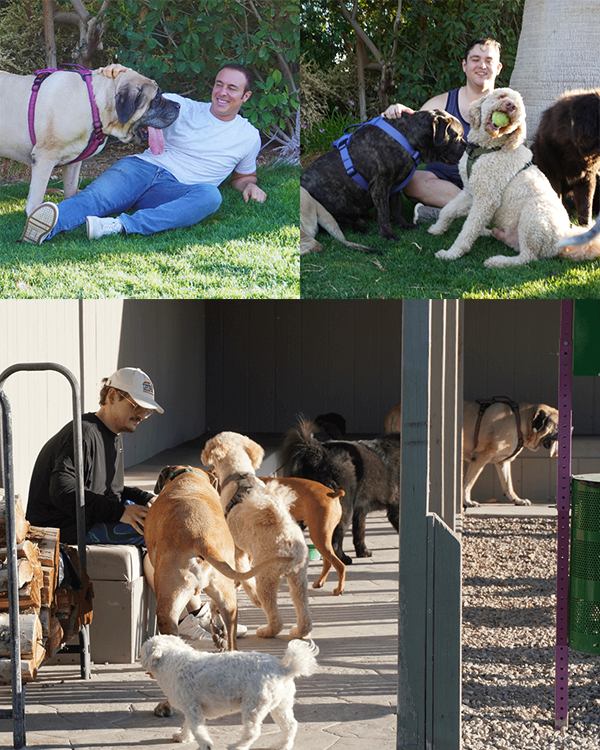
Cognitive Decline in Dogs: A Guide for the Journey Together
It often starts with a single, heart-stopping moment. Your dog, who has navigated your home for years, suddenly seems lost, standing and staring at a wall. Maybe they get stuck in a corner or forget the familiar path back from the yard. We understand those 3 AM searches for answers. If you're here, please know you're not alone.
This gradual change in a dog's awareness and behavior is known as cognitive decline, a process that shares similarities with dementia in humans. The good news is that recognizing these subtle shifts is the first and most important step. With understanding and supportive care, you can make a real difference in maintaining your dog's quality of life and creating more good days together.
That Heartbreaking Moment of Confusion
That quiet moment when you realize something is off can truly stop you in your tracks. You see your best friend, who knows every inch of your home, looking utterly lost. It’s a feeling that brings a pang of worry and a sense of helplessness that so many of us who love senior dogs have experienced.
This guide is for you. We’re here to walk this path with you, not as clinical experts in white coats, but as fellow dog lovers who get it. Together, we'll gently explore what's happening, focusing on providing comfort, support, and realistic hope for the road ahead. You and your dog deserve that.
More Than Just "Getting Old"
It’s tempting to brush off these early signs as just a normal part of aging. A little stiffness? Sure. Longer naps? Absolutely. But what we're talking about here are specific changes in their mental clarity that go beyond just getting older.
Think of it this way: An older dog might walk their favorite path a bit slower, but a dog with cognitive changes might forget where the path even leads.
"Small improvements can mean everything. Our goal isn't a miracle cure; it’s about creating more good days together, filled with comfort and moments of recognition."
What You Might Be Noticing
You know your dog better than anyone. Trust your instincts. Those little things you're picking up on are real, and they are the key to understanding what's going on and how you can start to help.
Some of the most common early moments of confusion include:
- Forgetting familiar routes: Pausing at the back door, seeming unsure how to come back inside.
- Staring into space: Getting "stuck" looking at a wall or into a corner for no reason.
- Unusual vocalizing: Barking, whining, or whimpering without an obvious cause, often at night.
- Changes in greetings: Losing that spark of excitement and no longer rushing to meet you at the door.
Simply noticing these signs isn't about jumping to a diagnosis. It's about beginning a new journey of support for your friend. Every small adjustment you make to provide comfort and stick to routines makes a massive difference. This guide is here to give you practical, real-world advice to help you maximize your dog's well-being on your shared path.
Get Your FREE Dog Brain Health Guide

Get instant FREE access to today's top ways to help your best friend live a longer, healthier, happier life.
- 39 value-packed pages of expert insights
- Early-detection tips for cognitive decline
- Top brain-boosting superfoods
- Vet-approved mental sharpness strategies
- Fun IQ tests for your dog
Recognizing the Subtle Signs of Change
The first signs are almost always quiet. So quiet, in fact, you might brush them off or wonder if you’re just imagining things. Maybe your dog seems a little more distant, or perhaps they stood at the wrong door to go outside yesterday. These small, fleeting moments are easy to miss, but they're often the first whispers of a changing mind.
You know your dog better than anyone. That gut feeling that something is just a little off? Trust it. Canine cognitive decline doesn't happen overnight; it’s a slow, gradual process. Your observation is the most powerful tool you have.
To help you make sense of what you're seeing, veterinarians often use a helpful acronym called DISHAA. It’s not a scary diagnostic tool, but rather a simple way to categorize the subtle behavioral shifts that can signal cognitive changes.
Common Signs of Cognitive Change in Your Dog (DISHAA)
Think of this table as a quick reference guide. It's designed to help you pinpoint specific behaviors you might be noticing at home, linking them to the common categories of cognitive decline.
| Category (DISHAA) | What You Might Notice |
|---|---|
| Disorientation | Getting stuck in corners, staring at walls, or seeming lost in your own home or yard. |
| Interactions | Seeming withdrawn, less interested in petting, or not greeting you at the door like they used to. |
| Sleep-Wake Cycles | Pacing or whining at night, but sleeping more than usual during the day. |
| House-Soiling | A previously house-trained dog suddenly having accidents inside. |
| Activity Changes | Less interest in playing or exploring; more aimless wandering or circling. |
| Anxiety | New fears, increased clinginess, or becoming easily startled by everyday sounds. |
Seeing these behaviors can be confusing and even upsetting. It's important to remember this isn't defiance or bad behavior—it's a sign that your dog's brain is changing, and they need your support in a new way. For instance, the sudden onset of anxiety can be particularly baffling, but there's a deep connection between anxiety and behavioral changes in dogs that's worth exploring.
How Common Is This, Really?
If you're noticing these signs, it's easy to feel like you and your dog are on an island. You’re not. Cognitive changes are a natural, and surprisingly common, part of the aging process for our canine companions.
The numbers really put it into perspective. Research shows that while it can start earlier, the risk of cognitive decline increases dramatically as dogs get older.
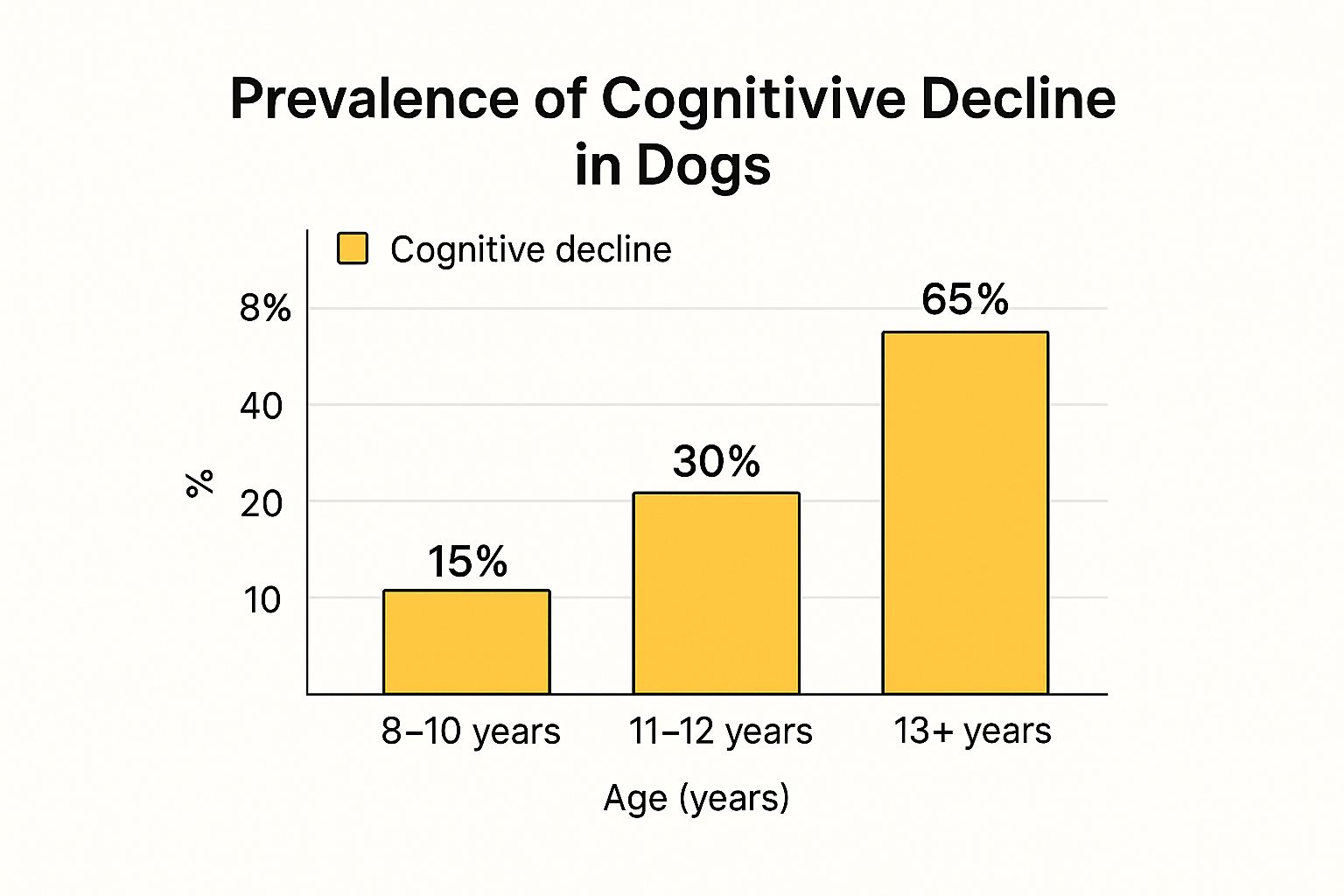
As you can see, the data tells a clear story. While 28% of dogs aged 11-12 show signs, that number jumps to a staggering 68% for dogs aged 15-16.
Seeing statistics like this can feel a bit heavy. But the key takeaway isn't the numbers themselves—it's knowing that what you're going through is a shared experience. This knowledge empowers you to shift from a place of worry to one of proactive, loving support.
By recognizing these signs early, you can start making small, meaningful adjustments to your dog’s environment and routine. Every little change you make helps create a world that feels safer and more predictable for them, ensuring you can continue to enjoy your precious time together.
What Happens Inside Your Dog’s Brain
It can feel frightening and confusing when you see changes in your long-time companion. But understanding what’s happening inside your dog’s mind can make the situation feel less like a mystery and more like something you can manage together. There are real, physical changes occurring that explain why they might seem forgetful or lost. Let’s gently walk through the science of it all.
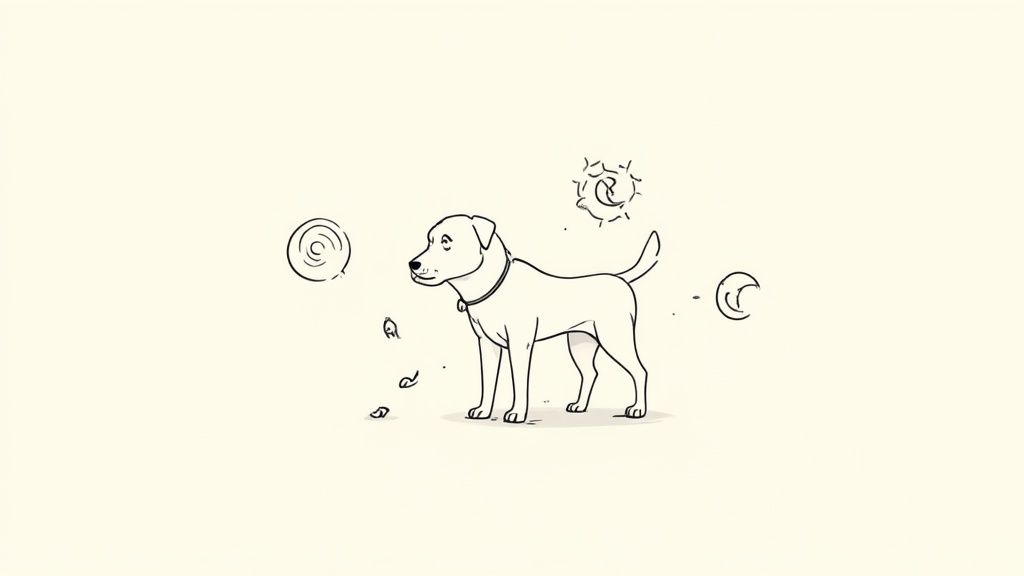
Think of your dog’s brain as a bustling city, with countless messengers zipping along well-maintained roads. In a young, healthy brain, these messages travel quickly and efficiently. As a dog gets older, however, some of these communication highways can start to get a little bumpy or even blocked.
This isn’t your fault, and it’s certainly not your dog’s. It's a natural biological process, just like a muzzle turning grey or joints getting a bit stiff. The first step in helping them is simply understanding what’s going on under the hood.
The Brain's Communication System
One of the main culprits behind these slowdowns is something called amyloid-β plaque. It's a mouthful, but you can just picture it as tiny, sticky "cobwebs" that build up between the brain's nerve cells over the years.
Just as real cobwebs would get in the way, these plaques interfere with the brain's signals, slowing down communication. This is what can lead to those moments of confusion you might be seeing—like when your dog stares blankly at the wall, forgets a command they've known forever, or seems unsure why they walked into a room.
The goal here isn't to turn you into a neuroscientist. It's to help you see that these behavioral shifts have a physical cause, which allows us to approach the problem with compassion instead of frustration.
A Familiar Parallel to Human Health
You might have heard that cognitive decline in dogs has a lot in common with Alzheimer's disease in people, and it’s true. The buildup of these "cobwebs" is a key feature of both conditions. In fact, studies estimate that between 14% and 67% of dogs over the age of eight experience some level of cognitive decline, with the risk skyrocketing as they get older.
But here’s the crucial, hopeful difference: unlike its human counterpart, many signs of cognitive decline in dogs can be effectively managed. With the right support, you can often slow the progression and even see improvements. This is a powerful reason for realistic optimism. Seeing your dog become more alert or fall back into familiar routines isn't just a dream—it's a real possibility.
How You Can Support Their Brain Health
Knowing what’s happening empowers you to take action. The goal shifts from worry to support, focusing on ways to maintain the brain's existing pathways and keep those cellular messengers moving freely.
You can do this with a few gentle, practical steps:
- Nutritional Support: Introducing key nutrients that act as "brain fuel" can help protect nerve cells and maintain cognitive function. Anything that supports healthy circulation is also a huge plus, ensuring the brain gets the oxygen it needs to thrive.
- Consistent Routines: A predictable schedule for meals, walks, and potty breaks creates a stable environment that reduces anxiety and confusion. It gives their brain a reliable map for the day.
- Gentle Mental Enrichment: Simple puzzle toys, "find the treat" games, or short, positive training sessions keep their mind active without causing stress or frustration.
Every dog's journey is different, but the path forward is always paved with love, patience, and proactive care. You are their most important advocate. For more ideas on this topic, feel free to explore our other articles on canine brain health. Our focus is on helping you create more good days, filled with the comfort, clarity, and connection you both deserve.
Creating More Good Days for Your Aging Dog
Once you start to grasp the 'what' and 'why' behind the changes in your old friend, the most important question becomes, "So, what can I do to help?" This is where hope really comes into the picture. It's about shifting your focus from worry to gentle, supportive action. We're not chasing miracle cures here; we're aiming for progress, not perfection. Our shared goal is simple but profound: to create more good days together.
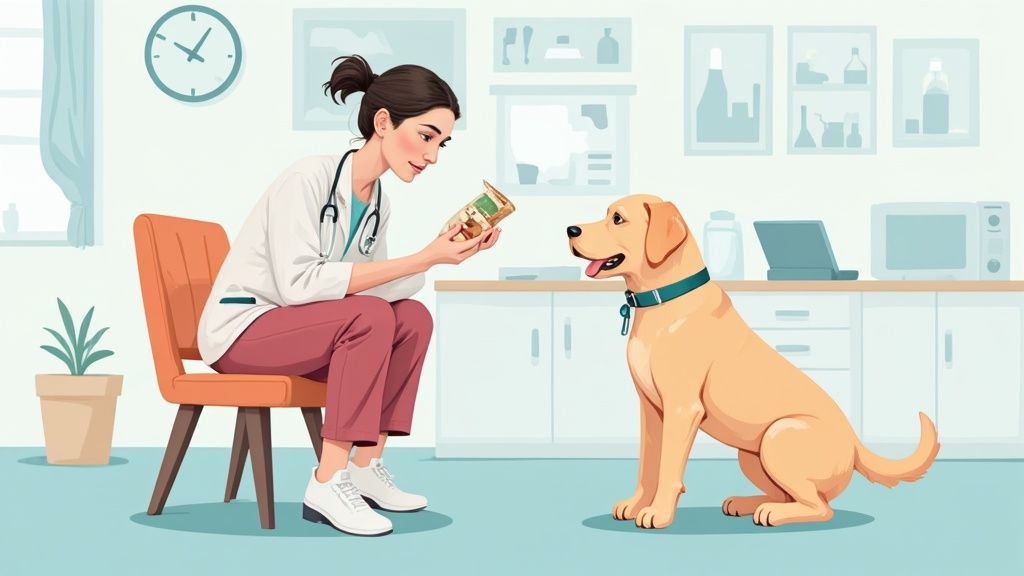
This journey is all about celebrating the small wins. A peaceful night's sleep, a flicker of recognition when you say their name, or a brief moment of playful tail-wagging—these moments matter more than ever. The good news is, you have the power to create an environment that supports your dog's comfort and clarity. It all comes down to a few key pillars of care.
The Power of Brain-Supportive Nutrition
Just like our own bodies need the right fuel to function, an aging dog's brain can get a real boost from specific nutritional support. Think of it as providing the essential building blocks to help support those crucial brain cell connections we talked about earlier. You don't need a Ph.D. in canine nutrition to make a real difference; you just need to know what to look for.
Certain natural compounds have been shown to play a big role in supporting cognitive function. Ingredients that support brain cell health, like Phosphatidylserine, can be incredibly helpful. Antioxidants work to protect the brain from everyday cellular stress. Other key nutrients can help with healthy blood flow, making sure the brain gets all the oxygen and resources it needs to do its job.
One of the most direct ways to introduce these elements is through a well-formulated supplement. Taking a look at how a daily supplement like NeuroBoost can help support your dog's brain health can be a fantastic first step.
Gentle Mental Enrichment
Keeping your dog's mind gently active is like a light workout for their brain. The key word here is gentle. We want to engage them, not frustrate them. A confused or anxious dog isn't going to benefit from a complicated puzzle. Instead, it's all about simple, rewarding activities that build their confidence back up.
A few easy ideas:
- Low-Stress Puzzle Toys: Use a slow feeder bowl or a simple "snuffle mat" for their meals. The act of sniffing and searching for food is a natural and wonderfully calming mental exercise.
- Simple Scent Games: While your dog is watching, hide a favorite (and slightly smelly) treat under a blanket or in a corner of the room. Then, cheerfully encourage them to "find it!"
- Short Training Tune-Ups: Revisit simple commands they’ve known their whole life, like "sit" or "paw." Keep it super positive and reward any effort they make. This helps reinforce those old, familiar neural pathways.
These small activities help maintain cognitive function by encouraging them to think and problem-solve in a completely low-pressure way.
Consistent Routines Create Comfort
For a dog dealing with cognitive decline, a predictable world is a calm world. When their own internal clock or sense of direction feels off, a consistent external schedule becomes their anchor. This is truly one of the most powerful and loving things you can do to reduce their anxiety.
"A stable routine for meals, walks, and bedtime doesn't just organize their day—it organizes their mind. It provides a reliable map when their own internal compass is struggling."
Try your best to stick to the same times each day for waking up, eating, potty breaks, and settling down for the night. This predictability cuts down on confusion and helps them feel safe and secure, which can dramatically lessen behaviors like nighttime pacing or anxious whining.
The Importance of Gentle Physical Activity
Don't forget that keeping their body moving is also crucial for their brain health. We're not talking about long hikes or strenuous games of fetch. Short, leisurely strolls are perfect. The goal is consistent, low-impact movement that supports healthy circulation, which in turn feeds the brain.
In fact, keeping a dog active is one of the most consistently effective lifestyle factors for supporting cognitive function as they age. Research shows a clear link between higher levels of physical activity and better cognitive health in older dogs. By weaving these four pillars—nutrition, enrichment, routine, and gentle exercise—into your daily life, you're not just managing the signs of cognitive decline in dogs. You are actively building a supportive, loving foundation for more good days, more moments of connection, and more shared comfort on this journey together.

Support Your Dog's Brain Health with NeuroChew™
As mentioned in this article, NeuroChew is the first dog chew designed to support both cognitive function and healthy circulation. Perfect for dogs showing early signs of cognitive decline or for proactive brain health support.
When to Talk with Your Veterinarian
You know your dog better than anyone. You know their quirks, their daily routines, and the subtle cues that signal how they're feeling. So, when that little voice in your head whispers that something just isn't right, it's time to listen. Making that call to the vet is a powerful, proactive step—it's a reflection of your love, not a sign that you've done something wrong.
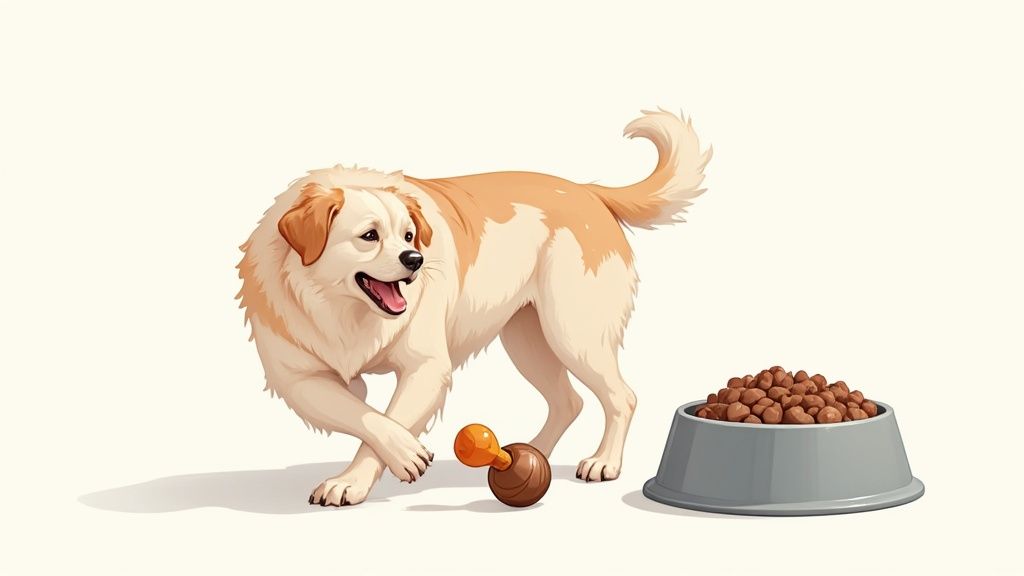
We get it, that call can be tough to make. You might worry you can't quite put your finger on what's changed, or that the vet will just chalk it up to "old age." But you don't have to figure this out alone. Your veterinarian is your most important partner in navigating this journey and building a plan to support your best friend.
Preparing for Your Appointment
To make the most of your visit, try to go in with specific observations. It’s hard for a vet to work with a vague feeling, but a concrete list of behaviors gives them a solid place to start.
A simple journal is your best friend here. For a week or two before the appointment, just jot down notes on your phone or in a small notebook. Think about:
- What happened? (e.g., "Stood staring at the wall for a few minutes.")
- When did it happen? (e.g., "Right after coming inside from the backyard.")
- How often is it happening? (e.g., "This is the third time I’ve seen this in the past week.")
This simple practice turns a general concern like "he seems confused" into actionable information like, "He consistently gets 'stuck' in the corner between the kitchen and the living room, usually in the evening."
Ruling Out Other Health Concerns
One of your vet's first and most important jobs is to play detective. So many physical health issues can mimic the signs of cognitive decline, and you have to rule those out before jumping to conclusions.
We measure success in peaceful nights and moments of recognition. A vet visit is the first step toward understanding the cause of those difficult moments, paving the way for more comfort and clarity for your dog.
For instance, a dog suddenly having accidents inside might have a urinary tract infection, not a memory problem. A dog who stops responding to their name could be losing their hearing. And if they're hesitant to play, it might be the pain of arthritis, not a loss of interest. Your vet will perform a thorough physical exam to investigate these possibilities, making sure you're addressing the right problem.
Starting a Collaborative Care Plan
Once other medical issues have been ruled out, you and your vet can have a real conversation about supporting your dog's brain health. This is a team effort. The reality is that cognitive decline in dogs is closely tied to age. One study found that the rate jumps from 18.8% in dogs aged 11-13 all the way to 45.3% in dogs between 13 and 15. You can read more about these age-related findings from the National Institutes of Health.
Sharing your journal notes and understanding these statistics opens the door to discussing things like nutritional support, simple changes to your home environment, and other strategies to maintain your dog's quality of life. Remember, you're not just there to report problems—you're there to start a partnership focused on creating as many good days together as you possibly can.
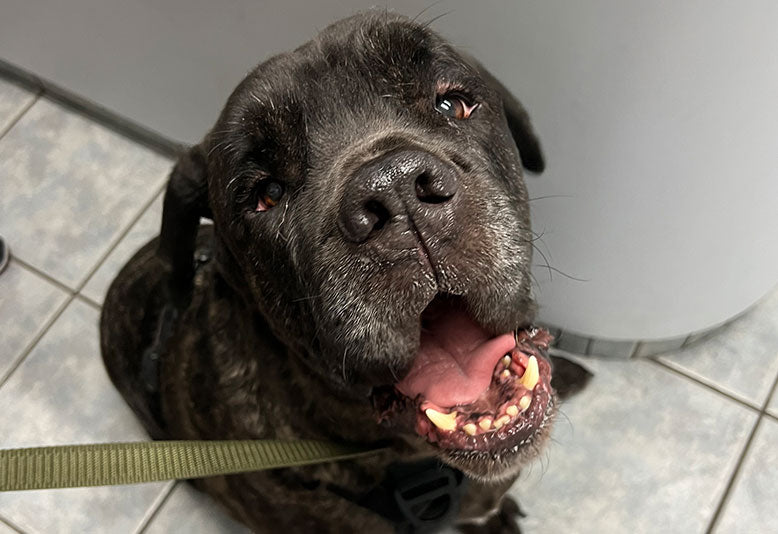
Real Results: How NeuroChew Helped Brutus Regain His Mental Clarity
Brutus was getting disoriented at night. After starting NeuroChew, he's more happy during the day and steady at night. He's back to his old self!
The Journey Forward with Hope and Comfort
Navigating the changes that come with cognitive decline in dogs is a journey of the heart, not just the head. It’s a process of adapting to a new chapter in your shared life—one that requires patience, understanding, and a deep commitment to their comfort. We know the worry that settles in when you see your best friend change, and it’s important to remember you are not alone on this path.
This isn’t about searching for a miracle cure. Instead, it’s about focusing on what we can do, right now, to make their world a little easier and more comfortable. Success is measured differently now. It’s in the peaceful nights, the brief moments of clear recognition, and the quiet contentment of a stable routine. Every small improvement is a victory worth celebrating.
Your dog gave you their best years, full of unconditional love and loyalty. Now, you have the beautiful opportunity to return that gift by providing gentle, compassionate support during their golden years. The bond you've built is the most powerful tool you have.
Key Pillars of Your Loving Support
As you move forward, focus on the simple yet profound ways you can make a difference. These are the cornerstones of creating more good days together and helping your dog feel safe, secure, and loved.
- Gentle Routines: Predictability is a powerful source of comfort. Sticking to a consistent schedule for meals, walks, and bedtime helps organize their world, especially when their internal compass feels off.
- Nutritional Support: Providing key nutrients that support brain health is a tangible way to help maintain their cognitive function and promote mental clarity.
- Mental Enrichment: Simple scent games or easy puzzle toys can keep their mind active without causing frustration. These small activities help reinforce their confidence.
- Your Presence: Never, ever underestimate the power of your companionship. Your calm voice, a gentle touch, and your reassuring presence are the greatest sources of comfort they have.
"Your dog’s world may be changing, but your love is their constant. Your care, your patience, and your companionship are the most meaningful support you can offer them through this chapter of your shared lives."
The road ahead might have its challenges, but it will also be filled with moments of deep connection and profound love. You are your dog’s greatest advocate and their safest harbor. By focusing on comfort, cherishing each good day, and leading with your heart, you are giving them the most precious gift of all—a peaceful and dignified journey, right by your side.
Your Questions About Dog Cognitive Decline, Answered
When you start noticing changes in your senior dog, it's natural to have a lot of questions. Being your dog's advocate means seeking out answers, and that's a powerful way to show how much you care. Let's walk through some of the most common questions we hear from loving pet parents.
At What Age Does Cognitive Decline Start in Dogs?
This is usually the first question on everyone's mind, but there's no single magic number. It really depends on the individual dog. We start to see the earliest, most subtle signs of cognitive decline in dogs pop up around age 8, particularly in larger breeds.
The chances increase more significantly once a dog hits 11 years old. The key isn't to get hung up on their exact age, but to pay close attention to your dog's behavior. If you notice little shifts from their lifelong normal, trust that instinct.
Can Cognitive Decline in Dogs Be Reversed?
This is a tough one, and it always comes from a place of deep hope. We're right there with you. As it stands, there's no "cure" that can fully reverse the physical changes happening in the brain with cognitive decline.
But—and this is a big but—that doesn't mean you're powerless. This is a journey of management and support, not miracles. Many of the symptoms can be managed in a way that truly makes a difference.
"While a complete reversal isn't on the table, the real goal is to support their brain health so well that you can significantly increase the number of good, clear, and happy days you get to share."
With the right combination of nutrition, mental enrichment, predictable routines, and help from your vet, many families see a wonderful improvement in their dog's day-to-day quality of life.
How Can I Tell If My Dog Is Just Getting Old?
It's completely normal to wonder where the line is between normal aging and something more. In the beginning, they can look frustratingly similar. A dog that’s simply aging might slow down on walks, sleep a bit more, or get some gray fur around their face.
Cognitive decline, however, brings more specific behavioral changes that point to confusion.
- Normal Aging: Taking longer to get up from a nap, not hearing you call them as quickly, or moving a little more stiffly.
- Cognitive Decline: Getting "stuck" in corners, forgetting which door leads outside, pacing anxiously at night, or suddenly seeming distant from the family.
If you’re seeing these more distinct behavioral shifts, that’s your cue to have a conversation with your vet. Nobody knows your dog better than you do, and what you've observed is the most important piece of the puzzle.
At Furever Active Ranch, we're dedicated to helping you support your dog through their golden years with gentle, natural care. NeuroChew was created to help maintain cognitive function and bring back some of the mental clarity your best friend deserves. It’s all about giving them more good days, together. Learn more about how NeuroChew can help your senior dog.
Share This Article

Support Your Dog's Brain Health with NeuroChew™
The first dog chew that supports both brain function and healthy circulation. Perfect for dogs of all ages.
- Enhances cognitive function & mental clarity
- Reduces anxiety without sedation
- Supports healthy blood circulation
- Made in USA with natural ingredients
60-Day Money-Back Guarantee • Free Shipping



